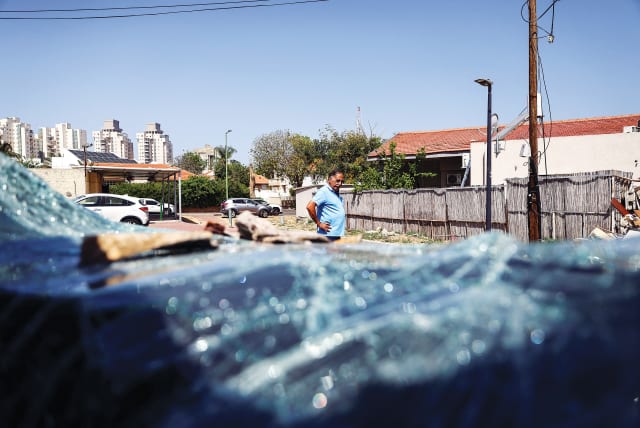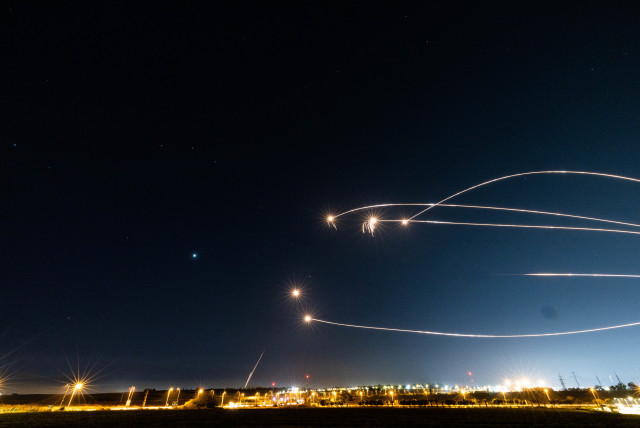The road to Gaza: Israel's latest clash with Palestinian Islamic Jihad

SECURITY AFFAIRS: Sometimes being out in the fields, watching rockets launched in front of you and Iron Dome interceptors screaming skyward behind you, is more reassuring than the sirens.
When Israel carried out airstrikes on three Islamic Jihad commanders this week, it seemed that a large conflict was imminent. Israel had called the operation Shield and Arrow. When Israel gives an operation a name, it must be significant. In addition, years of tensions with Islamic Jihad have taught us that the group is a serious threat. It has thousands of missiles, some of them with long ranges, and it is willing to use them.
In fact, the attack on Islamic Jihad brought back memories of other short conflicts on the border of Gaza. For a day Jihad appeared bewildered and shocked from the blows it had received, and it didn’t respond. This gave the residents around the Gaza Strip plenty of time to prepare. The smaller communities sent their children away, and schools were closed in areas around Gaza. This extended dozens of kilometers into Israel. Jihad was expected to shower the South with rockets.
After a day without a response, the second day dawned with a bit of haze in the air. It was May 10, and Israel had continued to try to interdict Jihad’s activities. There were concerns about the terrorist group bringing up anti-tank missiles, called “nun-tet” in Hebrew. There also appeared to be an attempt by Israel to strike at the group as it positioned its rocket launchers. This was different from May 2021 when Hamas fired massive salvos of rockets. Hamas appeared to have been well prepared for conflict, whereas Jihad perhaps was not.
As I headed south to cover the fighting, the usual steps played out. You get your bag for the day, an extra shirt in case its hot, an armored helmet, binoculars, a large bottle of water, because maybe you’ll be stuck somewhere, or your car will break down, or who knows what will happen. Then you begin the drive from Jerusalem. I’ve done this same drive so many times to cover wars on the border of Gaza since 2009 that the car could drive itself. But it’s not a Tesla, and it doesn’t have AI, so I can’t just tell it, “Take me to the war.”
Driving to Gaza
As you leave Jerusalem, going down Highway 1, you pass the memories of the 1948 war when Jerusalem was under siege and Jewish fighters had to use small armored cars to try to get up Sha’ar Hagai, the thin pass the road winds through as it goes uphill. So we’re doing history in reverse. We’re leaving behind 1948 and the Crusader fort at Castel and heading down to Gaza to see warfare in the 21st century.

Israel has been fighting terrorist groups in Gaza a long time, and both sides generally know how this will play out. The groups have rockets and anti-tank missiles and some naval commandos, but generally their moves will all be checked by the IDF. What they can do is fire rockets and harass Israeli communities, forcing people into shelters and armored rooms.
As I drove south the roads became increasingly sparse with traffic. The hill country of the Shfela, Israel’s Piedmont, gives way to the Coastal Plain. It was in these hills that the Jews of the period of the Judges fought the Philistines. Samson’s cave is here, near Beit Shemesh. Further south, as one approaches the Gaza border, there is an important fork in the road. Highway 3 has branched off from Highway 1 at Latrun, site of a famous 1948 war battle. Highway 3 joins Highway 40 and then continues on toward Ashkelon. You can take Route 232 to Sderot along the way.
Israel had closed off the roads around Gaza in anticipation of rocket fire, so you can go to Ashkelon or Sderot, but you can’t drive along the border between the two. I chose to go to Ashkelon.
Sderot has seen thousands of rockets fired at the community since Israel left Gaza. In the old days Sderot was a frontline community in this respect. The terrorist groups didn’t have long-range rockets. But then, after 2009, the ranges increased, and Israel’s Iron Dome became operational. The terrorist groups shifted their strategy, seeking to hit Ashkelon and Tel Aviv.
As I arrived closer to Ashkelon the sense of deserted streets became clear. The radio included an interview with a woman in Netiv Ha’asara, the community that sits on the Gaza border south of Ashkelon. She was in her shelter. The kids had been sent away.
I drove down there, as close as I could get to the border, using a few back roads that branch off the main road, which was blocked to traffic. Here there are agricultural fields and some trucks that still have to go back and forth to construction sites. There are no shelters on the road, and there are no sirens that can be heard either. So the only guide to help you know whether there is rocket fire is the radio, or watching Gaza and seeing the smoke trails.
When the rockets began
WHEN THE rockets began on May 10, they represented Islamic Jihad’s initial response. It fired 100 rockets in an hour, first at Sderot and then Ashkelon and then points further away. The familiar sound of Iron Dome interceptors erupting skyward was audible.
In Ashkelon the city was deserted, and people were staying home. IDF Home Front Command and the municipality had done a good job anticipating what might come next. This sense of normality was palpable. War is normal, but the situation is abnormal. Talk of a ceasefire began almost immediately, but no one believes it will hold.
These short operations have become more frequent and shorter. No more monthlong conflicts or ground operations in Gaza. This isn’t like back in 2014 when the fields were festooned with tanks churning up the melons that otherwise would have been agricultural bounty. We’ve learned a lot since 2014. But we’ve also gotten to the point where we fight endless conflicts against groups like Jihad and may be losing sight of the forest for the trees.
We can fight the conflicts with relative ease, but millions still see their lives interrupted. People aren’t supposed to gather, kids miss out on birthday parties or other events. And even though rockets falling on civilian areas are rare, due to Iron Dome, it does happen, and everyone must be on their guard.
Is Islamic Jihad deterred? What has Hezbollah learned from this recent round? For those of us who have gotten too used to this choreographed way of conflict, it’s puzzling to look out and realize that millions of people tethered to their bomb shelters for several days is not normal.
Sometimes being out in the fields, watching rockets launched in front of you and Iron Dome interceptors screaming skyward behind you, is more reassuring than being under the undulating wail of sirens that cause one to jerk up with momentary fear. That should not be a norm. But it is.
